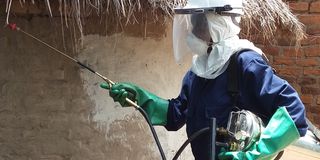Bukedi records sharp rise in malaria cases

Health authorities have relaunched indoor residual spraying in Bukedi to contain the spread of malaria. PHOTO/COURTESY PHOTO
What you need to know:
- Health officials attribute the cases to lack of awareness, misuse of mosquito nets, and poverty.
The sharp rise in malaria cases, especially among children and pregnant women, is worrying Bukedi Sub-region officials.
This is despite the government’s effort to contain spread of the disease through distribution of mosquito nets and conducting indoor residual spraying in the area.
Our mini-survey shows that some residents use the insecticide-treated mosquito nets to erect poultry shelters, garden boundaries and improvise ropes to tether livestock.
Health officials say districts with higher malaria cases are Kibuku, Pallisa, Butebo, Budaka, Butaleja, Tororo and Busia.
Dr Godfrey Buyinza, the Kibuku health officer, said malaria cases have been on the rise since last year.
“The situation is worrying in our district and if we had powers, we would have declared it an epidemic,” he said.
Records from the district health office indicate that four in every 10 patients who present at health facilities test positive for malaria.
The district registered 13,056 cases in January and 9,925 in February.
Dr Buyinza said the most affected sub-counties are Bulangila, Nankondo, Kibuku, and Kasasila.
Mr Rashid Simiyu, a medical officer at Kibuku Health Centre IV, said one in two patients at the facility is a malaria case.
“That number is high and the interventions to fight malaria seem not [to be] working,” he said, adding that residents have spurned the expert advice to sleep under insecticide-treated mosquito nets.
Mr Simiyu said malnourished children and pregnant women are the most infected.
In Pallisa, records show that malaria constitutes up to 45 percent of the diseases burden.
Mr Magidu Dhikusoka, the deputy Resident District Commissioner (RDC), appealed to the communities to embrace the indoor residual spraying as part of the measures to contain malaria spread.
Ms Topi Amusugut, the Budaka malaria focal person, confirms the surge in malaria infections.
Officials have relaunched indoor residual spraying in Bukedi to contain the spread.
In Butaleja, malaria peaked in the last quarter of 2021. For instance, the district registered 106,186 malaria infections between October and December, about three-fold higher than the 32,973 from January to March in the same year.
The district health inspector, Mr Henry Isongoli, attributed the increase in malaria cases to lack of awareness, misuse of nets, poverty, negative attitude to government programmes such as indoor spraying.
The district health officer, Dr Siraji Kizito, said as a result, seven out of every 10 patients in Butaleja test positive for malaria.
“Malaria cases are common among children under five years and pregnant women. Some patients delay getting treatment from health facilities leading some patients to develop severe anaemia and present with hematuria (blood in urine) which can turn fatal,” Dr Kizito said.
The Resident District Commissioner, Mr Apollo Webale, said from the onset of Covid-19 pandemic, a big percentage of children lived through the lock down with malaria.
A number were unable to access medical facilities either because of restricted movement or parents could not afford.
In Tororo, district officials said they record 1,000 malaria patients at all health facilities per day.
Dr Okoth Obbo, the district health officer, said 56 percent of outpatients suffer from malaria.
“We receive more than 1,000 people diagnosed with malaria in all health facilities. People are not using the mosquito nets for the main purpose,” he said.
Ms Margaret Mwanamoiza, the Kibuku RDC, said they are sensitising communities to mitigate malaria prevalence.
“We are distributing mosquito nets as a way to fight malaria in the district,” she said.
According to the Health Ministry, Uganda registers at least 16 malaria deaths per day out of 25,000 cases.





